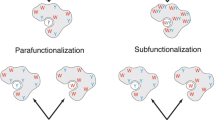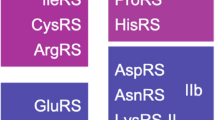Abstract
Aminoacyl-tRNA for protein synthesis is produced through the action of a family of enzymes called aminoacyl-tRNA synthetases. A general rule is that there is one aminoacyl-tRNA synthetase for each of the standard 20 amino acids found in all cells. This is not universal, however, as a majority of prokaryotic organisms and eukaryotic organelles lack the enzyme glutaminyl-tRNA synthetase, which is responsible for forming Gln-tRNAGln in eukaryotes and in Gram-negative eubacteria. Instead, in organisms lacking glutaminyl-tRNA synthetase, Gln-tRNAGln is provided by misacylation of tRNAGln with glutamate by glutamyl-tRNA synthetase, followed by the conversion of tRNA-bound glutamate to glutamine by the enzyme Glu-tRNAGln amidotransferase. The fact that two different pathways exist for charging glutamine tRNA indicates that ancestral prokaryotic and eukaryotic organisms evolved different cellular mechanisms for incorporating glutamine into proteins. Here, we explore the basis for diverging pathways for aminoacylation of glutamine tRNA. We propose that stable retention of glutaminyl-tRNA synthetase in prokaryotic organisms following a horizontal gene transfer event from eukaryotic organisms (Lamour et al. 1994) was dependent on the evolving pool of glutamate and glutamine tRNAs in the organisms that acquired glutaminyl-tRNA synthetase by this mechanism. This model also addresses several unusual aspects of aminoacylation by glutamyl- and glutaminyl-tRNA synthetases that have been observed.
Similar content being viewed by others
References
Baron C, Böck A (1995) The selenocysteine inserting tRNA species: structure and function. In: Söll D, RajBhandary U (eds) tRNA: Structure, biosynthesis and function. American Society for Microbiology, Washington, DC, pp 529–544
Breton R, Sanfacon H, Papayannopoulos T, Biemann K, Lapointe J (1986) Glutamyl-tRNA synthetase of Escherichia coli: isolation and primary structure of the gltX gene and homology with other aminoacyl-tRNA synthetases. J Biol Chem 261:10610–10617
Carter CW Jr (1993) Cognition, mechanism, and evolutionary relationships in aminoacyl-tRNA synthetases. Annu Rev Biochem 62:715–748
Cusack S (1993) Sequence, structure and evolutionary relationships between class 2 aminoacyl-tRNA synthetases—an update. Biochimie 75:1077–1081
Deutscher MP (1967) Rat liver glutamyl ribonucleic acid synhetase. I. Purification and evidence for separate enzymes for glutamic acid and glutamine. J Biol Chem 25:1123–1131
Folk WR (1971) Molecular weight of Escherichia coli glutaminyl transfer ribonucleic acid synthetase, and isolation of its complex with glutamine transfer ribonucleic acid. Biochemistry 10:1728–1732
Gupta R (1984) Halobacterium volcanii tRNAs: Identification of 41 tRNAs covering all amino acids and the sequences of 33 class I tRNAs. J Biol Chem 259:9461–9471
Lamour V, Quevillon S, Diriong S, Van Cong N, Lipinski M, Mirande M (1994) Evolution of the Glx-tRNA synthetase family: the glutaminyl enzyme as a case of horizontal gene transfer. Proc Natl Acad Sci USA 91:8670–8674
Lapointe J (1982) Study of the evolution of the genetic code by comparing the structural and catalytic properties of the aminoacyl-tRNA synthetases. Can J Biochem 60:471–474
Lapointe J, Duplain L, Proulx M (1986) A single glutamyl-tRNA synthetase aminoacylates tRNAGlu and tRNAGGln in Bacillus subtilis and efficiently misacylates Escherichia coli tRNAGGln1 in vitro. J Bacteriol 176:88–93
Loftfield R (1963) The frequency of errors in protein biosynthesis. Biochem J 89:82–92
Moras D (1992) Structural and functional relationships between aminoacyl-tRNA synthetases. Trends Biochem Sci 17:159–164
Nagel GM, Doolittle RF (1995) Phylogenetic analysis of the aminoacyl-tRNA synthetases. J Mol Evol 40:487–498
Nureki O, Vassylyev DG, Katayanagi K, Shimizu T, Sekine S, Kigawa T, Miyazawa T, Yokoyama S, Morikawa K (1995) Architectures of the class-defining, subclass-defining and specific domains of glutamyl-tRNA synthetase from Thermus thermophilus. Science (in press)
Perona JJ, Rould MA, Steitz TA (1993) Structural basis for transfer RNA aminoacylation by Escherichia coli glutaminyl-tRNA synthetase. Biochemistry 32:8758–8771
Rogers KC, Söll D (1993) Discrimination among tRNAs intermediate in glutamate and glutamine acceptor identity. Biochemistry 32: 14210–14219
Rould MA, Perona JJ, Söll D, Steitz TA (1989) Structure of E. coli glutaminyl-tRNA synthetase complexed with tRNAGln and ATP at 2.8 Å resolution. Science 246:1135–1142
Schimmel PR, Söll D (1979) Aminoacyl-tRNA synthetases: general features and recognition of transfer RNAs. Annu Rev Biochem 48:601–648
Schön A, Kannangara CG, Gough S, Söll D (1988) Protein biosynthesis in organelles requires misaminoacylation of tRNA. Nature 331: 187–190
Sedlmeier G, Linti G, Gregor K and Schmieger H (1993) Sequences of tRNA-encoding genes and associated open reading frames of Streptomyces lividans. Gene 132:125–130
Sherman JM, Rogers KC, Rogers MJ, Söll D (1992) Synthetase competition and tRNA context determine the in vivo identity of tRNA discriminator mutants. J Mol Biol 228:1055–1062
Söll D (1988) Enter a new amino acid. Nature 331:662–663
Söll D, Schimmel PR (1974) Aminoacyl-tRNA synthetases. In: Boyer P (ed) The enzymes, vol. 10. Academic Press, New York, pp 489–538
Sprague GF Jr (1991) Genetic exchange between kingdoms. Curr Opin Genet Dev 1: 530–533
Sprinzl M, Hartmann T, Weber J, Blank J, Zeidler R (1989) Compilation of tRNA sequences and sequences of tRNA genes. Nucleic Acids Res 14:r1–4172
Strauch MA, Zalkin H, Aronson AI (1988) Characterization of the glutamyl-tRNAGln-to-glutaminyl-tRNAGln amidotransferase reaction of Bacillus subtilis. J Bacteriol 170:916–922
Swanson R, Hoben P, Sumner-Smith M, Uemura H, Watson L, Söll D (1988) Accuracy of in vivo aminoacylation requires the proper balance of tRNA and aminoacyl-tRNA synthetase. Science 242: 1548–1551
Tremblay T-L, Lapointe J (1986) The so-called tRNAGGlu1 of Escherichia coli is a stable denatured conformer of the major isoacceptor tRNAGlu2. Biochem Cell Biol 64:315–322
Verkamp E, Kumar AM, Lloyd A, Martins O, Stange-Thomann N, Söll D (1995) Glutamyl-tRNA as an intermediate in glutamate conversions. In: Söll D, RajBhandary U (eds) tRNA: Structure, biosynthesis and function. American Society for Microbiology, Washington, DC, pp 545–550
Wilcox M, Nirenberg M (1968) Transfer RNA as a cofactor coupling amino acid synthesis with that of protein. Proc Natl Acad Sci USA 61:229–236
Woese CR (1987) Bacterial evolution. Microbiol Rev 51:221–271
Wong JTF (1975) A co-evolution theory of the genetic code. Proc Natl Acad Sci USA 72:1909–1912
Zinoni F, Birkmann A, Leinfelder W, Böck A (1987) Cotranslational insertion of selenocysteine into formate dehydrogenase from Escherichia coli directed by a UGA codon. Proc Natl Acad Sci USA 84:3156–3169
Author information
Authors and Affiliations
Additional information
Based on a presentation made at a workshop—“Aminoacyl-tRNA Synthetases and the Evolution of the Genetic Code”—held at Berkeley, CA, July 17–20, 1994
Correspondence to: D. Söll
Rights and permissions
About this article
Cite this article
Rogers, K.C., Söll, D. Divergence of glutamate and glutamine aminoacylation pathways: Providing the evolutionary rationale for mischarging. J Mol Evol 40, 476–481 (1995). https://doi.org/10.1007/BF00166615
Received:
Issue Date:
DOI: https://doi.org/10.1007/BF00166615




